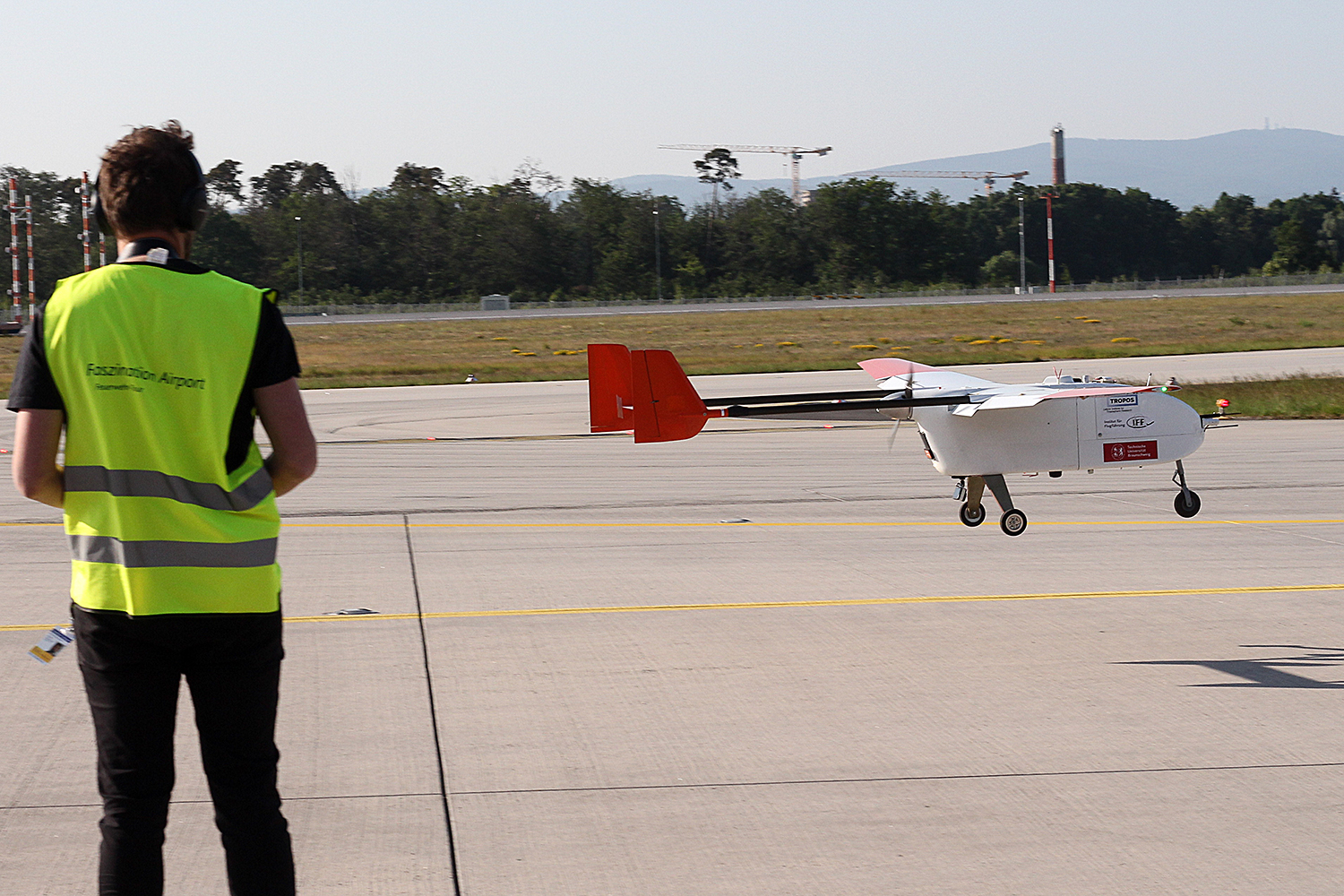“ALADINA cleared for takeoff“ TU Braunschweig drone prepares for use in study on fine dust pollution from air traffic
Ultrafine dust can penetrate the lungs and thus trigger respiratory diseases. As part of a study for the Forum Flughafen und Region (FFR) (Forum Airport and Region), various research groups are investigating the influence of air traffic and other sources such as road traffic and industry in the region around Frankfurt Airport on the population’s exposure to ultra-fine dust. The Institute of Flight Guidance at Technische Universität Braunschweig is also involved with the unmanned research aircraft ALADINA.

ALADINA and the team from Fraport and TU Braunschweig before the transponder tests on the north-west runway of Frankfurt Airport (from left: Rebecca Kohl, Andreas Schlerf, Lutz Bretschneider, Sven Bollmann). The shiny metallic surface on top is the transponder antenna. Photo credit: Sven Bollmann/TU Braunschweig
Over the next three years, various measurements and simulations of the release and dispersion of ultrafine particles (size range smaller than 100 nanometres) in the Rhine-Main Region are planned. The ultrafine particle (UFP) pollution study is funded by the Umwelt- und Nachbarschaftshaus (Environmental and Neighbourhood House), the office of the Forum Flughafen und Region (FFR), and coordinated by the Leibniz Institute for Tropospheric Research in Leipzig. It is part of a comprehensive research project of the FFR in which, in addition to the exposure of the population to ultrafine dust, its health effects are also being investigated in a further step.
Distribution of ultrafine dust as as a function of altitude
As part of the project, the Institute of Flight Guidance at TU Braunschweig is planning measurements of ultra-fine dust particles, in particular their distribution as a function of altitude. For this purpose, the unmanned research aircraft ALADINA (Application of Light-Weight Aircraft for Detecting In-situ Aerosol) will be used, which was already used to measure the distribution of fine dust with altitude in the control zone of BER airport in October 2021.
The concentration of air pollutants depends strongly on the nature of the atmosphere: If there is a temperature inversion, the pollutants accumulate near the ground. With strong mixing at altitude, the pollutants distribute with altitude and over a greater distance, so that there are lower concentrations near the ground. The distribution of pollutants with altitude thus provides important information for simulations.

ALADINA after successful transponder tests shortly before landing in Frankfurt. Photo credit: Sven Bollmann/TU Braunschweig
First tests at the airport successful
Special safety precautions are necessary for the preparation of drone flights in the vicinity of airports. Among other things, the unmanned measuring aircraft ALADINA is equipped with a transponder for this purpose and is thus displayed to other aircraft and the air traffic controllers. As a runway at Frankfurt Airport is currently not in operation due to repair work, the transponder, the flight radio equipment and the procedures for planning and carrying out the flights could be tested there at short notice at the start of the project.
“The short-term tests conducted by TU Braunschweig together with the operating company of Frankfurt Airport, the Fraport AG, and the Deutsche Flugsicherung (DFS) (German Air Traffic Control) were very successful due to the fast and good cooperation,” reports Lutz Bretschneider from the Institute of Flight Guidance, who is the safety pilot responsible for take-off and landing as well as monitoring the flights. “ALADINA flew without disturbing flight operations at Frankfurt Airport. The transponder signal was visible throughout the flight. The flight envelope was maintained as planned. Communication with the air traffic controllers worked very well.”
This means that the Institute of Flight Guidance can now go into the detailed planning for the ultra-fine dust measurements.
What is ultrafine dust?
Ultrafine dusts are the smallest particles of fine dust. They are smaller than 100 nanometres (= 0.1 micrometres) and thus significantly smaller than the usually considered fine dusts PM10 or PM2.5, which have a maximum size of 10,000 nanometres and 2,500 nanometres respectively. Due to their small size, ultra-fine dust particles can penetrate the lungs particularly easily and even enter the bloodstream.
Project data
In April 2023, the first of two central projects to assess the region’s exposure to ultrafine particles (UFP) and their health impacts started with the “UFP-Belastungsstudie“ (UFP Exposure Study) commissioned by the Umwelt- und Nachbarschaftshaus (UNH), office of the Forum Flughafen und Region (FFR). The exposure study is being conducted by a consortium led by the Leibniz Institute for Tropospheric Research (TROPOS). The completion of the exposure study is expected in 2026.
